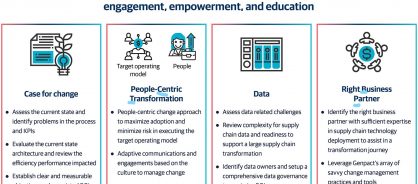- Point of view
A framework to accelerate supply chain technology ROI

Statista predicts that the size of the supply chain management (SCM) software market worldwide will reach a valuation of over $16 billion in 2028.1 But can investing in new tools alone elevate supply chain performance? User adoption of these supply chain tools is more crucial than you think when determining ROIs and associated business benefits. And with user acceptance of the right tools, you can streamline and automate your supply chain operations to improve visibility and efficiency and prevent dollar leakages.
However, ensuring adoption can be challenging. After hundreds of digital transformation projects, we've discovered that the core hindrance to adoption is finding the right technological solution that meets functional requirements without being overly complex or expensive. Here are the three most common technology adoption challenges the supply chain faces today.
- The fear of change. Clients often worry that integrating new technology will break the existing architecture. And it's no surprise that the integration procedure is sometimes complex. Plus, the steep learning curve and often limited training in these technologies prevent users from adopting them. And let's not forget that tribal knowledge prevails in traditional working styles, so people end up seeing new technology as a threat to their jobs.
- Bad data erodes trust. In today's world, data guides our choices. But can you trust your data if you're unsure of its quality? Many organizations lack control and governance over data – a critical step in managing data assets and ensuring data quality. Poor quality data can lead to variable outputs resulting in low trust among users. You require technically sound teams, effective governance processes, and strong leadership to overcome your data challenges.
- The hide and seek of ROIs and operating models. Quantifying your ROI is hard. In conversations with our clients, we've often encountered concerns over investing in digital initiatives. And thanks to ROI worries, securing transformation buy-ins becomes even more challenging. More so when companies consider adding new technology as a miracle fix to their process problems. But if you're not paying attention to your operating models, people could fall back to the old styles of working and mountains of spreadsheets.
Conquer the technology adoption curve
Our work with our clients across industries has helped us devise a framework (see figure 1) that rests on a solid Data-Tech-AI foundation – a powerful mix of our data, technology, analytics, and AI services – to accelerate technology adoption.
Figure 1: Our technology adoption framework for the supply chain

Build a solid case for change
In our experience, a highly systematic approach from the pre-enablement phase is crucial. We partner with clients to build an internal team to champion each digital initiative. After all, you need strong advocates for the new technology within your respective departments. Begin with a clear understanding of what success means to you in terms of business requirements, ROIs, and key performance indicators (KPIs). And assign an executive sponsor who will hold your vendors accountable and align teams to broader goals.
Put people first
The next step is to identify the people who will lead your initiative and empower them to make tough decisions. How? You set up a comprehensive training strategy to continuously upskill. They are your early adopters of new tools and technologies who help build trust in your team. Train your leads to identify existing processes that need overhauling to maximize technology compatibility. And they can work with the broader teams to avoid overly complex designs that can hinder company-wide digital adoption. Additionally, put these stakeholders in the driver's seat during the design and implementation phases so they stay invested.
Use data to point true north
Now comes the most challenging but essential step – capitalizing on your data and make sure it's fit for purpose. Begin with making data accessible to business users with accuracy, relevancy, and consistency across different systems and departments. Properly collated and governed data will provide the insight your business needs for better decision-making. Data cleansing, in parallel to technology implementation, yields the best results. By doing this, businesses can reduce risk and optimize performance due to poor data quality.
Choose your business partner mindfully
Last but not least – your partner matters. Selecting the right business partner for technology adoption initiatives is vital for running your project successfully and cost-effectively while improving your organization's end-user experience and productivity. The best partners bring fresh perspectives and the capabilities to help you navigate technology choices, trade-offs, and design customizations to deliver on your ultimate vision.
Case study: Embedding digital in forecasting
One of our US-based clients, an audio equipment manufacturer, wanted to improve demand forecast accuracy for its new products. The problem? The company's traditional forecasting techniques were harming revenue and reputation. The solution? A future-ready supply chain with better visibility into operations. Armed with our framework and Data-Tech-AI capabilities, we found that predictions based on outdated spreadsheets and other unnecessary manual efforts slowed down the company's speed to market. We conducted workshops, refreshed processes, redesigned the company's operating model, and built a machine-learning-based forecasting methodology now running as a managed service. The impact? This end-to-end transformation delivered a more agile, accurate, integrated, and accessible supply chain, drastically improving new product introduction (NPI) demand forecast accuracy by almost 65%.
The trail you blaze: Know your reasons for technology adoption
We have seen companies try to implement innovative technologies without considering the long-term impact – a rookie mistake. Before implementing a technology, make sure you're doing it for the right reasons.
- Begin with a technology adoption assessment exercise
- Assess whether you can rewire your existing technology to perform more advanced functions. If not, identify a technology/tool that can fit the requirements and has the potential to scale
- Understand how bringing a new solution would affect your operating model, business processes, and organizational structure
- Ask yourself whether the decisions align with your broader goals/KPIs. Do a pulse check of your user community and its ability to accept a new way of working
- Get your training strategies on point by embedding industry-specific context
- Evaluate your user's ability to run the new solution. If they can't use the technology despite upskilling, go back to the drawing board and try tweaking your business model
Technology adoption is a journey of managing expectations on many levels and can test patience and grit. But in a scenario where your data insights, talent, processes, and technology all operate in tandem, you'll drive a higher ROI and elevate the performance of your supply chain.
1 Lionel Sujay Vailshery, Supply chain management (SCM) software market revenues worldwide from 2019 to 2026, Statista, June 1, 2023.
The authors of this POV are: